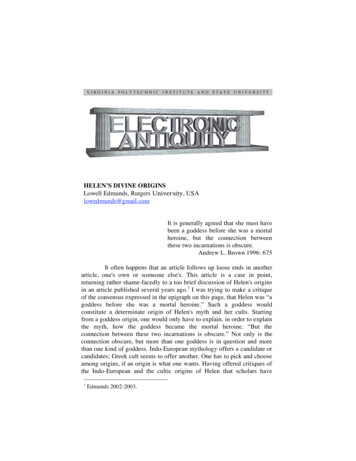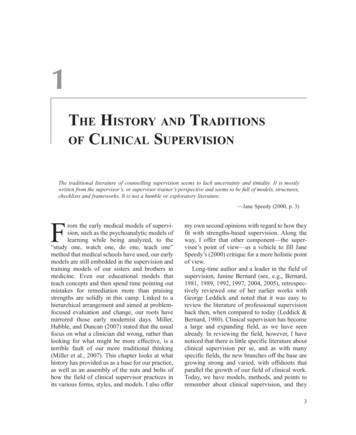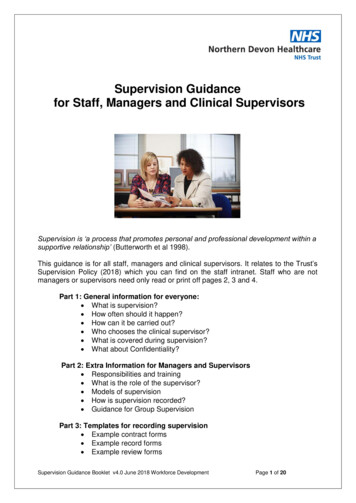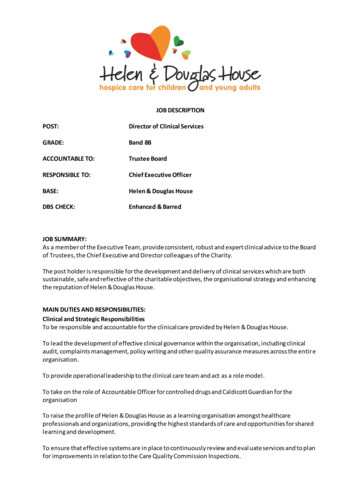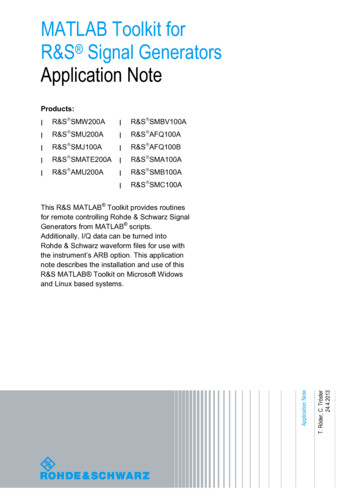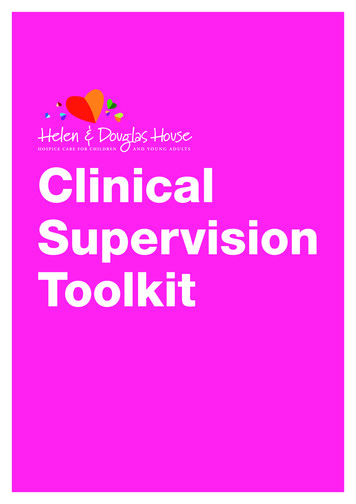
Transcription
ClinicalSupervisionToolkit
Meet the TeamThe Helen & Douglas House clinical supervision project team are (L to R):Kate McTaggart AdministratorLucie Mayer Clinical Supervision Practice Development FacilitatorSophie Ebeling Organisational Lead for Clinical SupervisionJulie Levinge House Manager with Portfolio for Staff Support & Well-BeingRichard Brennan e-learning Development TechnicianThe Helen & Douglas House Clinical Supervision Toolkit reviewand development of the Introduction to Clinical Supervisione-learning module has taken place between January and April 2014.We hope you find this toolkit a useful resource to support you learningabout and participation in clinical supervision.We would like to thank all those who have generously given their timeand shared their expertise to support and inform this review of the ClinicalSupervision Toolkit. The clinical supervision project team, the toolkit reviewand e-learning module have been funded by a grant from Health EducationThames Valley. It has been designed by Chris Woodrow.Please do get in touch with any questions or feedback you would like to share.Telephone: 01865 794749 or email: education@helenanddouglas.org.ukHelen & Douglas House14A Magdalen RoadOxfordOX4 1RWThe authors and editors have, as far as it is possible, taken care to ensure that the informationgiven in this toolkit is accurate and up to date at the time it was created. Helen & Douglas Houseis not responsible for the content of any external websites. Users are strongly advised to confirmthat the information complies with current legislation and standards of practice. Helen & Douglas House Clinical Supervision Toolkit 2014
ClinicalSupervisionToolkit
ContentsA Note About Terms6Background to the Toolkit6Introduction7The Toolkit8Part 1What is Clinical Supervision?Towards a definitionWhat’s in a name?Historical perspectiveReflectionHow might clinical supervision be delivered?The Helen & Douglas House menu ofclinical supervision and support opportunities9101214141618Why do we need Clinical Supervision?Functions of clinical supervisionBenefits of clinical supervision for participantsBenefits of clinical supervision for teams and organisations21242628Tools for Clinical SupervisionWhat do we mean by tools?Models and frameworks we have adopted at Helen & Douglas HouseA model for clinical supervisionReflective models and frameworks3133333436Part 2Clinical Supervision: Information for ParticipantsRoles and responsibilitiesBarriers to engaging in clinical supervisionContractingConfidentialityRecord KeepingTraining and skillsPreparationEvaluation4Helen & Douglas House Clinical Supervision Toolkit434445474848495152
Clinical Supervision: Information for FacilitatorsRoles and responsibilitiesContractingRecord KeepingBarriers to engaging in clinical supervisionSelf-carePreparationTraining and skillsEvaluationDevelopmentAide-mémoire for facilitatorsTips for practice555758596062636468696970Clinical Supervision: Information for Managers & OrganisationsGetting it right for your organisationComparing and contrasting other professional support to clinical supervisionLeading by exampleStatutory requirements for the provision of clinical supervisionRoles and responsibilitiesContractingRecord keepingBarriers to engaging in clinical supervisionTraining and skillsPreparationEvaluationDevelopmentTips for practice7173737676777778798083848587Clinical Supervision at Helen & Douglas House: Our Story So Far89Clinical Supervision: ResourcesContractingRecord keepingFacilitator self assessmentClinical supervision assessment99100105108118Further ReadingThe role and benefits of clinical supervisionImplementing clinical supervisionGuidance119120121122Helen & Douglas House Clinical Supervision Toolkit5
A Note About TermsThe literature tends to refer to people who are participating in supervisionare ‘supervisees’ and to those who are facilitating supervision as‘supervisors’. The possibility for confusion arising around the similaritiesin these terms and the simple difficulty of saying them both regularly, oftenin the same sentence, led those with a responsibility for clinical supervisionat Helen & Douglas House to adopt new terms. Hence those participatingin supervision are referred to as ‘participants’ and those deliveringsupervision are referred to as ‘facilitators’.BackgroundHelen & Douglas House is an independent hospice charitybased in Oxford, providing supportive and specialist palliativecare to children and young adults.There are two hospice houses: Helen House for children from birthto 18 years, and Douglas House for young adults up to the age of 35.Each offers specialist symptom and pain management, medically-supportedshort breaks and end-of-life care, as well as counselling and practicalsupport for the whole family.The publication of the first edition of this toolkit in 2011 markedan acknowledgement of the long history of reflection on practiceand clinical supervision at Helen & Douglas House. Clinical supervisionis widely acknowledged as a way of promoting safe accountable practice.For us, developing the toolkit was the beginning of a journey to refresh andrenew our organisational commitment to and vision for clinical supervision.As our experience has continued to grow and our vision has begunto be realised, we have embraced clinical supervision in its widest sense,to support all staff and volunteers whose role brings them into directcontact with patients and families. In recognition of that this secondversion is aimed broadly at those working within the helping professions.Although we hope this toolkit may also be helpful for those workingin other disciplines, we acknowledge that much of the literature andindeed the experience that we have drawn upon to develop this toolkitare rooted in nursing and healthcare.6Helen & Douglas House Clinical Supervision Toolkit
IntroductionFor all of us who work in the helping professions, caring for othersis at the heart of working life.For us to be able to provide compassionate, person-centred care inan increasingly complex world, we need to care for ourselves. We needto engage in a parallel process that gives us experience of person-centredsupport and development: clinical supervision.In this second version of the Helen & Douglas House Clinical Supervision Toolkit,we have retained what our experiences have taught us is useful and relevant,while adapting, adding and updating where necessary. What hasn’t changedis our organisational commitment to clinical supervision. We want to shareour learning and our experiences in the hope that we will inspire you to reflect,grow and imagine the possibilities for clinical supervision where you are.Part 1 of the toolkit is for everybody working in the helping professionsand beyond. We aim to provide an overview of the role of clinical supervisionas a mechanism for supporting well-being and good practice. We exploredefinitions, benefits and tools to support the provision of clinical supervision.Part 2 is made up of three chapters that provide tailored informationfor participants, facilitators, and managers & organisations.For participants the toolkit: Introduces the concept of clinical supervision and reflection. Explores why we need clinical supervisionand how it supports us in our work. Offers suggestions about preparing forand participating in clinical supervision.For actual and potential facilitators the toolkit: Introduces the role of the facilitator. Explores the skills needed for effective facilitationand considers how these can be developed. Offers suggestions about self-care.For managers & organisations the toolkit: Introduces the role of managerial and organisational support in clinicalsupervision delivery, policy development and service evaluation. Explores resource implications of clinical supervision delivery. Offers suggestions about implementing anddeveloping clinical supervision provision.Helen & Douglas House Clinical Supervision Toolkit7
The ToolkitThis toolkit has been developed as a resource, both for those alreadyinvolved in clinical supervision and those developing an interest.In each section of this toolkit you will find activities to help you focus onyour own thoughts and experiences regarding the various aspects of clinicalsupervision. They are provided with the aim of supporting your learningand skills development to be relevant to you in your individual situation.By working through this toolkit you will have the opportunity to developthe skills and awareness to engage effectively with clinical supervision.Taking a proactive approach to developing and participating in clinicalsupervision in your organisation will enable you to derive optimumbenefits from it.8Helen & Douglas House Clinical Supervision Toolkit
Part 1What isClinicalSupervision?Helen & Douglas House Clinical Supervision Toolkit9
Towards a definitionThere have been many attempts to define clinical supervision:The Care Quality Commission states that “The purpose of clinicalsupervision is to provide a safe and confidential environment for staffto reflect on and discuss their work and their personal and professionalresponse to their work. The focus is on supporting staff in their personaland professional development and in reflecting on their practice.” 1The Royal College of Nursing states “[Clinical supervision is] the termused to describe a formal process of professional support and learningwhich enables practitioners to develop knowledge and competence,assume responsibility for their own practice and enhance consumerprotection and the safety of care in complex clinical situations.It is central to the process of learning and to the expansion of thescope of practice and should be seen as a means of encouragingself-assessment and analytic and reflective skills.” 2Hawkins and Shohet suggest “Supervision can be an importantpart of taking care of oneself, staying open to new learning, andan indispensable part of the individual’s ongoing self-development,self-awareness and commitment to learning.” 3Bishop and Sweeney described it as “A designated interaction betweentwo or more practitioners within a safe and supportive environment,that enables a continuum of reflective critical analysis of care, to ensurequality patient services and the well-being of the practitioner.” 4In essence all definitions of clinical supervision describefive key aspects:1 A reflective component.2 Support from a skilled facilitator.3 Focus on clinical practice (including team dynamics,communication and personal coping).4 Professional development.5 Improving patient treatment and care.10Helen & Douglas House Clinical Supervision Toolkit
elen & Douglasouse ExperienceIn practice we have found it helpful to consider a definitionwhich reflects what happens in clinical supervision.As part of the clinical supervision training offered to facilitatorsat Helen & Douglas House, course participants are encouragedto come up with their own definitions:“Clinical supervision provides a support network with lotsof different options, one of these is for a group of us to gettogether to talk about difficulties, to talk about things whichhave gone well, to gain support and learn together.”“Clinical supervision is about engendering an organisationalculture which provides a safe environment to support everystaff member and promote excellence in practice”“The aim of clinical supervision is to provide a flexibleframework of support for all staff and volunteers so thatstandards of care can be improved and maintained”“Clinical supervision is an opportunity, supported by theorganisation, for its workforce to explore their personal andprofessional feelings evoked by their work. It takes place ina formal, structured and contained environment with a clearestablishment and understanding of its boundaries.”ActivityTake some time to think about what clinical supervisionmeans to you, in your own work life and within your teamor organisation.From these thoughts and ideas, try to come up with your ownpersonal definition of clinical supervision.Helen & Douglas House Clinical Supervision Toolkit11
What’s in a name?The term clinical supervision is in itself problematic. It is welldocumented that, for some, the term raises concerns about beingwatched, controlled and monitored, which can in turn lead toresistance to taking part. 5If the concept were being developed today it is likely that a different namewhich more clearly highlights the supportive intention of the process wouldbe chosen.Some analogies from prominent authors in the fieldof clinical supervision may offer a different perspective:1 “Super – vision” – developing a super form of vision throughwhich we can take a fresh and deeper look at our experiencesin our work. 32 “Making sense of the swampy lowlands of clinical practice”– examining the subtle and unseen aspects of our experiencesof working life. 63 “ Putting practice under the microscope” – taking an in-depthlook at a specific aspect of our experience that has touchedus in some way. 7As we have broadly considered what clinical supervision is, it maybe helpful to compare this to what clinical supervision should not be.ActivityTake some time to consider what clinical supervision is,how we can use the space and what happens in the space.Having done that, think about what clinical supervision is not,the things we should not use that space for and things whichshould not happen in that space. List your thoughts either in your head oron paper and compare the different ideas. How does this compare with your experience of clinical supervision?12Helen & Douglas House Clinical Supervision Toolkit
What clinical supervision is and what it is notThis table is compiled from literature sources and also from participant’sresponses in Helen & Douglas House clinical supervision training.Clinical supervision is:Clinical supervision is not: An exploration of therelationship betweenactions and feelings. A tool for professionaldevelopment. A safe place. A place of learning. Supportive. A place to shareburdens of work. A structured frameworkfor reflection. Mutually supportive for all. Open to questionsand challenges. About listeningand being heard. Inclusive. Affirming. Self-driven/self-ownedby participants. Supportive of personalaccountability. A means of checkingup on practice. A judgement onyou or your practice. An assessment. A performancemanagement tool. Therapy (although itmay be therapeutic). Counselling or anopportunity to practiceas a counsellor. Controlled and deliveredby managers. Part of thereporting process. A teaching session. Mentoring by the facilitator. Appraisal. A “personal soap box”. A place for snooping. A place for blame. A place to run downother membersof the team. A place for thefacilitators’ agenda. A dumping ground,or place for gossipingor moaning.Helen & Douglas House Clinical Supervision Toolkit13
Historical perspectiveClinical supervision has a long history in the helping professions,particularly in counselling and social work. Due to the variety of rolesundertaken in medicine, nursing and allied healthcare professions,clinical supervision has adapted over the years to meet the broaderneeds of practitioners.From a nursing perspective, clinical supervision was first described in termsof being a systematic tool for improving practice in the 1993 Departmentof Health strategic document A Vision for the Future. 8Clinical supervision was introduced widely into the nursing professionto encourage the use of reflective practice, sharing of informationand supporting staff in their development. 2ReflectionThe concept of reflection is an integral part of clinical supervision.In order to fully participate in clinical supervision it is necessaryto understand what reflection is, and how to practice it.Reflection, simply described, is an “activity in which people recapturetheir experience, think about it, mull it over and evaluate it”. 9Reflection is not a purely intellectual activity: it is a dynamic process thatrequires us to pay attention to the feelings evoked by an event and invitesideas about how things could be done differently.Reflection requires “a combination of thinking, emotion and commitmentto action”. 10ActivityReflecting on practice is likely to be something that you dowithout realising.As you consider these definitions of reflection, draw to mind anexperience from your own practice that, at the time, felt difficult,challenging or uncertain. Try to recall your reflections from that time.Notice the aspects you reflected on, and notice any changes inyour perspective now.14Helen & Douglas House Clinical Supervision Toolkit
Reflection is a powerful tool to enable learning from ourexperiences. Facilitated reflection is particularly effectivebecause it: Acts as a catalyst to think differently. Enhances motivation that may falter during every day experiences. Assists a move from anxiety into positive energy for action. Addresses the gap between actual and desirable practice. Promotes deeper and critical levels of reflection. Challenges participants to respond differentlyin the practice situation. Supports clinicians to act on their insights with integrity. Supports staff morale during difficult times. Enables supervisees to be heard and re-energised.Information and activities to help you develop your reflective skillsare provided in Tools for Clinical Supervision (page 31) andInformation for Participants (page 43) sections.Helen & Douglas House Clinical Supervision Toolkit15
How might clinicalsupervision be delivered?In the simplest terms clinical supervision is guided reflection.GroupPeerIndividualIt can be delivered in many different formats. The three main modes of delivery, as wellas some possible benefits and challenges associated with them, are highlighted here:16DescriptionPossible benefits May be provided regularlyfor individuals with a singlenamed facilitator over anextended period of time. Can be ad hoc, as requestedto deal with specific incidentor issue. May include brief interventions. Development of trustingrelationships between facilitatorand participant maximisingopportunity for challengeand growth. Ad hoc sessions usefulfor providing more immediatesupport and opportunitiesfor learning from difficultsituations that arise. Usually involves two or moreparticipants facilitating their ownsessions. These participants areusually experienced in clinicalsupervision or have previouslyacted as facilitators. Can also involve participantsrotating into the role of observerwho gives feedback at the endof the session (also knownas triadic supervision). May be easier for some peopleto engage with – comfort inusing skills and resources oftrusted colleagues to supportreflection on actions/events. Can be helpful as usually thoseinvolved will be familiar withthe situation being discussed. Can be provided in fixed groupsof peers or colleagues operatingat similar level with regularnamed facilitator. Or in fluid drop-in groups witha pool of alternating facilitators. Safety and trust can be builtup over time in fixed groups. Great potential to shareknowledge and experienceand learn from each other. Cost effective way ofproviding access to regularclinical supervision.Helen & Douglas House Clinical Supervision Toolkit
Individual organisations andmanagers will need to decide onthe most appropriate way of deliveringclinical supervision in their situationfor their employees. It may be thata range of options are required.Possible challenges Expensive to deliver tolarge numbers of peopleon regular basis. Facilitator and participant needto be appropriately matched. Need enough identifiedand trained facilitators in anorganisation to be able to providean ad hoc service reliably.It may be helpful to offer participantsa choice of how they can engagein clinical supervision. It is likelythat participants will have their ownpreferences, based on a numberof factors including their personalityand any past experience of takingpart in clinical supervision. Sessions may become tooinformal, lacking the processand challenge to enable growth.The responsibility for providingsupervision rests with the designatedmanagers within an organisation.The responsibility for getting the mostout of clinical supervision rests withthe individuals taking part. Facilitators need to be skilledat managing group dynamicsas well as the reflective process. Drop-in groups can feel toounsettled for some participants. Ground rules and process need tobe agreed at each drop-in sessionwhich can be time consuming.Helen & Douglas House Clinical Supervision Toolkit17
elen & Douglasouse ExperienceThe Helen & Douglas Housemenu of clinical supervisionand support opportunitiesAt Helen & Douglas House the clinical supervision needs of themajority of staff and volunteers are largely met through drop-ingroup supervision. These group sessions have no fixed membershipand are convened weekly by a rolling bank of trained facilitators.However it is recognised that this drop-in group supervision mayneed to be supplemented by clinical supervision in a different format.When facilitators are trained, they are given the opportunityto develop the skills to provide a range of supportive interventions,which enables them to deliver much of what is on offer on theclinical supervision menu.Some specialist support, as well as clinical supervision for our seniormanagement team, is provided by outside facilitators. Clinical incidentanalyses and debriefs after a death or a critical incident are usuallyled by one of the medical team, a senior member of the family supportteam, or the clinical supervision lead.18Helen & Douglas House Clinical Supervision Toolkit
Participants at Helen & Douglas House can choose from the following menu: Drop-in groups – facilitated sessions are availableon a weekly basis, there is no fixed membership. Peer supervision. Individual supervision. Debrief after a death or a critical incident. Critical incident analysis. Brief interventions – where a participant identifies a facilitatoron an ad hoc basis, usually at point of challenge to getfocused support with dealing with a particular issue. External clinical supervision – the services of an external facilitatorare used to support staff in senior clinical management roles. Personal reflection. Sessions to support volunteers whose role brings theminto direct contact with patients and families. Ad hoc sessions on a needs-led basis to support staff in non-clinicalroles who have direct contact with patients and families (e.g. fundraisers).Our clinical supervision policy states that staff must participate in a minimumof six episodes of clinical supervision per year. The format can be chosen bythe participant, but cannot rely solely on written reflection or peer supervision.Evidence of participation in clinical supervision is documented by the participant(see Resources section, page 99) and must be provided at appraisal.Helen & Douglas House Clinical Supervision Toolkit19
References1 CareQuality Commission (2013) Supporting Information and Guidance: Supporting EffectiveClinical Supervision. London: Care Quality Commission2 RoyalCollege of Nursing (2002) Clinical Supervision in the Workplace: Guidance for OccupationalHealth Nurses. London: Royal College of NursingP and Shohet, R (1989) Supervision in the Helping Professions (1st Edition).Maidenhead: Open University Press3 Hawkins,4 Bishopand Sweeney, (2006) cited in Bishop, V (ed.) (2007) Clinical Supervision in Practice(2nd Edition). Basingstoke: Palgrave-Macmillan5 Cassedy,P (2010) First Steps in Clinical Supervision – A Guide for Healthcare Professionals.Maidenhead: Open University Press6 Schön,D (1991) The Reflective Practitioner: How Professionals Think in Action. Surrey: Ashgate7 Butterworth,T (1992) cited in Bond, M and Holland, S (1998) Clinical Supervision for Nurses.Milton Keynes: Open University Pressof Health (1993) NHS Management Executive: A Vision for the Future. The Nursing,Midwifery and Health Visiting Contribution to Health and Health Care. London: Stationery Office8 Department9 Boud,Keough and Walker (1985) Reflection: Turning Experience Into Learning. London: Kogan Page10 Bulman,C and Shultz, S (eds), (2004) Reflective Practice in Nursing (3rd Edition). Oxford: BlackwellC (2007) Towards Easing Suffering Through Reflection. Journal of Holistic NursingVol. 25, No. 3 204-21111 Johns,20Helen & Douglas House Clinical Supervision Toolkit
Why do weneed ClinicalSupervision?Helen & Douglas House Clinical Supervision Toolkit21
22Helen & Douglas House Clinical Supervision Toolkit
Why do we needClinical Supervision?Most practitioners will recognise the weighty feeling that can beexperienced when providing care for those in pain or distress, of workingin conditions where interpersonal dynamics are difficult, or when we arerequired to perform at the limits of our comfort or capabilities.Working in the helping professions, we may feel that carrying these burdensis par for the course. The culture of helping suggests that we need to carrythese burdens discreetly and to present a professional front.Clinical supervision is a space where we can explore the effects of our work,and make sense of the feelings our work evokes. It provides the opportunityto replenish reserves and bolster our resilience by considering new strategies.It enables us to consolidate learning and celebrate our achievements.elen & Douglasouse ExperienceAt Helen & Douglas House we recognise that our desireis always to do the best that we can for those that wecare for. If we are to be enabled to provide compassionate,non-judgemental care for our patients, we need to exploreand learn from all that happens while providing that care.Our commitment to clinical supervision at Helen & DouglasHouse is a recognition of the fact that without structured supportmechanisms to help us hold the stresses associated with our work,it can become unsustainable.Helen & Douglas House Clinical Supervision Toolkit23
Functions of clinical supervisionThe benefits derived from clinical supervision can be related to the functionsof clinical supervision identified by Proctor. 1LearningAccountabilityThis interactive model of clinical supervision describes three key componentsof effective clinical supervision: accountability, learning and support.Accountability is also referred to as the normative component.It focuses on supporting individuals to develop their ability andeffectiveness in their clinical role, enhancing their performancefor and within the organisation. The aim is to support reflection onpractice with an awareness of local policy and codes of conduct. Supports delivery of a high standardof ethical, safe and effective care. Enhances performance.Learning is also referred to as the educative component. It enablesparticipants to learn and continually develop their professional skills,fostering insightfulness through guided reflection. It focuses on thedevelopment of skills knowledge, attitudes and understanding. Supports personal and professional development. Encourages and supports lifelong learning. Helps to identify further training and development needs.SupportSupport is also referred to as the restorative component. It isconcerned with how participants respond emotionally to the workof caring for others. It fosters resilience through nurturing supportiverelationships that offer motivation and encouragement and that canalso be drawn upon in times of stress.24 Supports self-care and well-being. Provides insight into our emotional responses. Enhances morale and working relationships.Helen & Douglas House Clinical Supervision Toolkit
ActivityReflect on your own experiences of clinical supervision to date.Consider how these three functions have been present, or not,in your clinical supervision.You may find it helpful to consider: Whether any of the functions dominated the session. Whether any of the functions were absent. Which interventions/questions/reflectionssupported each of the functions. Whether you feel more comfortable or less comfortablewith any functions in relation to the others, and whythis might be the case for you.Helen & Douglas House Clinical Supervision Toolkit25
Benefits of clinicalsupervision for participantsIn a busy working life it can be very difficult to find the time and energyrequired to engage in clinical supervision.In a culture where we put the needs of others before our own it takescourage to acknowledge our own needs. Participating in clinical supervisionis a measure of the value we place on ourselves as individuals.The Nursing and Midwifery Council identified the possible benefitsof receiving effective clinical supervision as:“Improved capacity to identify solutions to problems, increasedunderstanding of professional issues, improved standards of patientcare, opportunities to further develop skills and knowledge andenhanced understanding of own practice.” 2The Care Quality Commission guidance suggests:“It can help staff to manage the personal and professional demandscreated by the nature of their work. This is particularly important forthose who work with people who have complex and challenging needs– clinical supervision provides an environment in which they can exploretheir own personal and emotional reactions to their work. It can allow themember of staff to reflect on and challenge their own practice in a safeand confidential environment. They can also receive feedback on theirskills that is separate from managerial considerations.” 3It has been argued that effective clinical supervision and the possibilityfor learning, development and support it provides can be protective againstwork related stresses. 426Helen & Douglas House Cl
The Helen & Douglas House clinical supervision project team are (L to R): Kate McTaggart Administrator Lucie Mayer Clinical Supervision Practice Development Facilitator Sophie Ebeling Organisational Lead for Clinical Supervision Julie Levinge House Manager with Portfolio for Staff Support & Well-Being Richard Brennan e-learning Development Technician The Helen & Douglas House Clinical .
